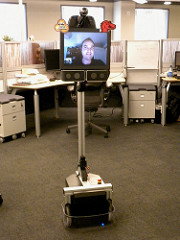Have you ever wanted to be in two places at once?
With the help of telepresence robots, you can! Users can control these robots from remote locations and see everything through the robot’s cameras. They can go to work without ever physically leaving their homes. However, even with the help of these robots, people with limited mobility or paralysis find it difficult to move from place to place. Normal telepresence robots are controlled by joystick remotes, or are semi-autonomous; for example, the AVA 500 has an automatic function where the user selects the robot’s destination using an app. However, initial set up at the robot’s site is required beforehand. Using a joystick remote seems simple enough, but it’s inconvenient for the user to manually control it all the time. People who are completely or partially paralyzed may find it difficult to use the remote since they may not be able to use their arms and hands. With motor disabled people in mind, researchers were able to create telepresence robots that are controlled by the user’s brain.
A team of researchers led by Professor José del R. Millán at the Swiss Federal Institute of Technology’s Defitech Foundation Chair in Brain-Machine Interface is developing a brain-computer interface that may be useful for the motor disabled. The robot (still undergoing development), consists of a laptop on a wheeled frame with a camera and sensors. Skype is used for communication between the user and other people.
Image Source: Luca Sage
The robot is controlled by the user’s neuron impulses, which are detected by a special cap with electrodes connected to the robot. To move it, the user has to put on the cap to move it as desired. Nineteen test participants tested the robot; nine were physically disabled and ten were healthy. All participants were able to successfully and completely learn how to control the robot using the cap quickly. Disabled participants could easily control the robot within under ten days of training. Their performances were fairly equal to those of the healthy participants, based on a test of how well each individual could make the robot move from room to room.
Although this project is still ongoing, there are high hopes that such a robot will greatly benefit people with motor disabilities in the near future.
Feature Image Source: Beltznerbot by Jennifer Morrow










